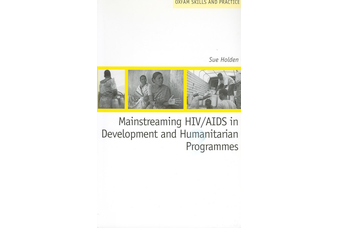Aids on the Agenda – lite
AIDS on the Agenda is quite a long book, so in 2004 Oxfam produced this cut down version of it.
You can download it for free or buy a hard copy from Oxfam publications.
Extract
AIDS depends for its success on the failures of development. If the world was a fairer place, if opportunities for men and women were equal, if everyone was well nourished, good public services were the norm, and conflict was a rarity, then HIV (Human Immunodeficiency Virus) would not have spread to its current extent, nor would the impacts of AIDS (Acquired Immune Deficiency Syndrome) be as great. We now know that the spread of HIV and the effects of AIDS are closely linked to development problems such as poverty and gender inequality. Development and humanitarian agencies should be doing more to respond to the challenges posed by HIV/AIDS. This book suggests a way in which they can do so through their existing work without necessarily establishing special programmes of HIV prevention or AIDS care.
This book is a shorter, simplified version of AIDS on the Agenda (Holden 2003), a book which can be ordered from Oxfam GB, or downloaded for free from here. The ideas in the two books are the same; but this version, we hope, is accessible to a wider range of readers: those who actually do development and humanitarian work, in addition to those who manage it and fund it. Unlike AIDS on the Agenda, this book does not feature quotations and case studies; instead it presents general lessons learned – mainly from the experiences of non-government and community-based organisations (NGOs and CBOs) working in the parts of Africa that are worst affected by HIV/AIDS. AIDS has changed the world. This book is about the changes that we need to make in order to do effective development and humanitarian work in a world of AIDS.
Part 1: The case for mainstreaming HIV/AIDS
Chapter 2 considers the two-way relationship between under-development and the causes and consequences of HIV/AIDS. It shows how the disease can make gender inequality worse, and claims that HIV/AIDS is a long-term development problem with no obvious solution.
Chapter 3 explores what mainstreaming means, by setting out the four main terms used in this book: • AIDS work • integrated AIDS work • external (programmatic) mainstreaming of AIDS • and internal (organisational) mainstreaming of AIDS. It identifies similarities and differences between them, and gives practical examples of what the terms mean for development and humanitarian organisations.
Chapter 4 addresses the question ‘Why mainstream HIV/AIDS?’. It considers some of the problems that may arise if development and humanitarian organisations fail to take AIDS into account in their ordinary work. It also responds to some objections to the idea of mainstreaming HIV/AIDS, and describes two problems which development organisations may meet when they do AIDS work.
Chapter 5 draws together all the elements of Part 1. It presents a ‘web’, showing four levels of influence on HIV transmission, and different kinds of response, both direct and indirect.
Part 2: Ideas for mainstreaming HIV/AIDS
Chapter 6 provides some general strategies for initiating and sustaining mainstreaming, and proposes some guiding principles. Chapter 7 offers ideas for mainstreaming HIV/AIDS within the internal operations of development and humanitarian agencies, and Chapters 8 and 9 offer suggestions for external mainstreaming in development and humanitarian programmes respectively. Chapter 10 presents an overview of the issues and challenges involved in promoting and adopting the strategy of mainstreaming, and the book concludes with Chapter 11.

